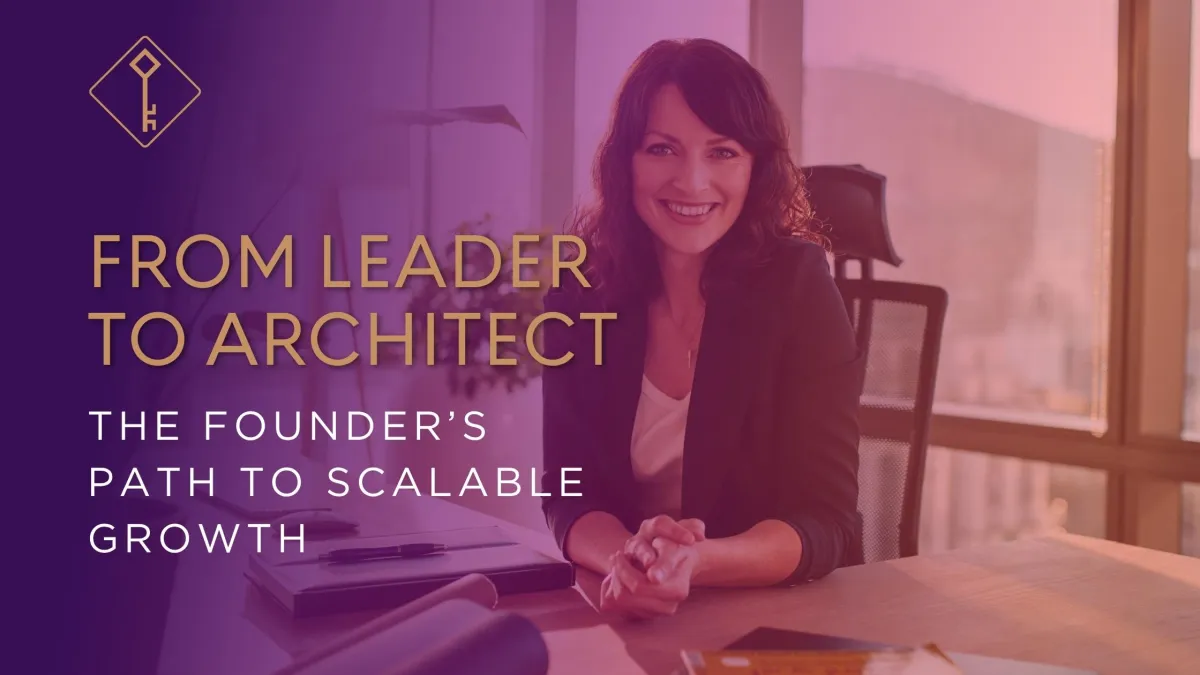
The Founder’s Path to Scalable Growth
Summary:
When it comes to building a company with staying power, leadership alone isn’t enough. This article breaks down the mindset evolution from tactical leadership to visionary architecture—helping you navigate the complex terrain of scaling with strategy, purpose, and clarity. Whether you're running a startup, stepping into the C-Suite, or architecting your next big chapter, this piece will challenge how you think—and how you lead.
Founder vs. Leader: How to Think Like the Visionary Your Company Actually Needs
"If you're still the engine of your company, you're not yet the architect of its future."
Most leadership advice will tell you how to be more efficient, more inspirational, more productive.
But when you're a founder—those aren't your most important priorities.
Because founder leadership isn't about showing up as your best self.
It's about building the kind of business that can grow even when you're not in the room.
This week, we're going deeper than tactics.
We're looking at how to grow intentionally—as a founder, not just a leader.
Because if you're building something worth scaling, you're going to have to lead differently.
The Three Mindset Traps That Limit Founders
1. The Personal Development Trap:
You over-index on self-growth, but not strategy.
Leadership books, communication skills, and "imposter syndrome" hacks might make you feel like you're doing the work. But if you're not thinking five moves ahead for your organization, you're not growing—you’re optimizing in place.
Here's an alternate perspective:
Yes, develop yourself. But evolve with a purpose: to build decision-making maturity and to architect systems that can outlive you.
2. The Big Idea Trap:
You obsess over your product, not your infrastructure.
Many founders double down on the brilliance of their idea—refining, tweaking, trying to perfect the offering. But the vision isn't just the thing you're building. It's the vehicle that gets you there.
If you’re not creating operational clarity, scalable systems, and a sustainable team ecosystem, your idea will suffocate under its own brilliance.
A new vantage point:
Your big idea doesn’t need more attention—it needs a business model that protects it.
3. The Identity Trap:
You are the business—and that’s the problem.
Early on, you wore all the hats. You did what needed to be done. But growth requires detachment. You’re not the business. You're the visionary who enables it to grow.
A different approach:
Start asking: If I stepped away for 3 months, what would break? Then build around that.
From Individual Leader → Organizational Architect
To lead at scale, founders must transition from center of gravity to systems steward.
This means zooming out:
Who are your stakeholders—and what does value look like to each of them?
Are you organizing your team around outcomes, or simply tasks?
Does your business have identity clarity—a clear UVP, internal vision, and operational heartbeat that others can align to?
If you’re still “needed” everywhere, the business isn’t designed for scale. It’s designed around your presence.
And that’s the bottleneck.
Red Team Thinking: Scaling Requires Conflict-Ready Decision Making
In Red Team Coaching, we challenge assumptions by modeling the mental biases and blind spots baked into our decision-making. This is especially critical for founders, who often operate in echo chambers of their own ambition.
Ask yourself:
Do my key leaders understand the why behind our direction—or just their part of the how?
Are our metrics lagging reality because we don’t challenge them often enough?
Am I building a team of operators—or architects who can challenge, build, and lead independently?
Founders who think in systems rather than silos build companies that last.
It’s Not About You. It Never Was.
You’re not the strategy. You set the direction.
You develop the people.
You shape the playbook and give others the tools to run it.
The more the company depends on your presence to function, the less scalable it becomes.
If you want to build a business with legacy-level impact, you have to unhook your self-worth from your daily output. Because long-term success isn’t about being essential.
It’s about becoming replaceable—not in value, but in function.
Final Thought
Founders don’t scale by doing more.
They scale by doing less of what looks like work—and more of what creates vision alignment.
Leadership got you here.
Systems thinking will get you there.
Now ask yourself:
If I’m not building a company that can grow without me, what exactly am I building?
Want to build the kind of business that doesn’t need you in every meeting?
Join the Powerhouse Legacy Collective—where vision becomes a strategy.
You Might Also Like:
The Psychology of Influence: Build Trust Before You Speak
Master the Four Executive Communication Styles That Define Leadership Impact
The Science of Influence & Executive Presence

